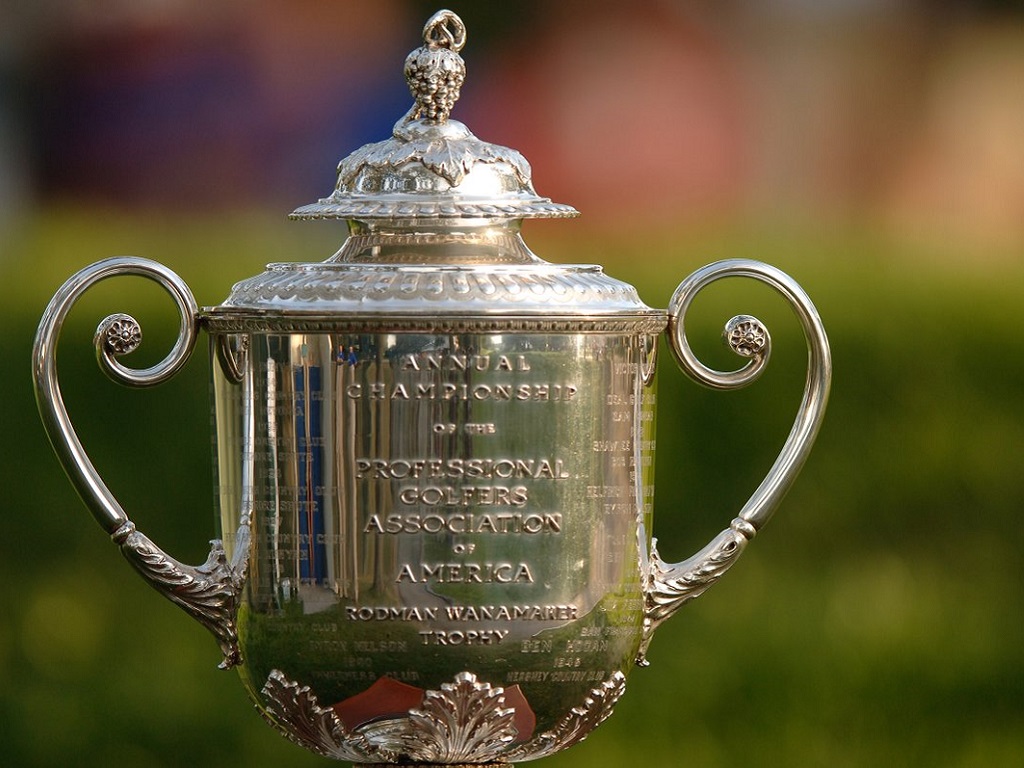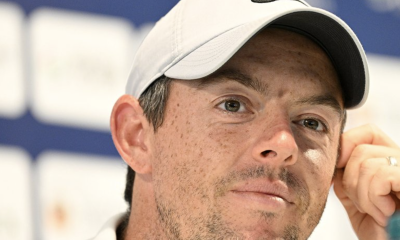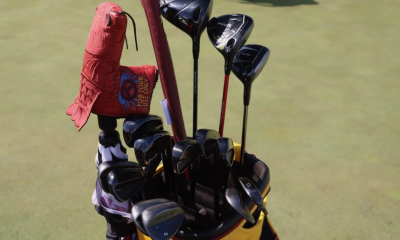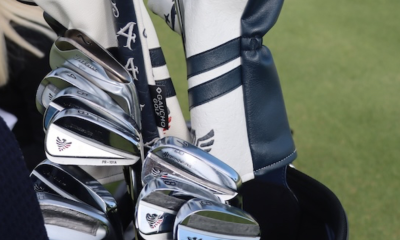News
The Lengths That We Drive To
 Driver shaft lengths are way way too long – there I’ve said it. It’s a comment that is unlikely to win me many friends among the OEMs but over the last few years driver shafts have become so long that they have begun to work against the guy swinging the club. Despite all the technology the we now see in driver heads – and more recently in the shafts – the madness seems to have gotten so far that we have passed a tipping point and we’ve started to lose the benefits that all these technological breakthroughs brought us.
Driver shaft lengths are way way too long – there I’ve said it. It’s a comment that is unlikely to win me many friends among the OEMs but over the last few years driver shafts have become so long that they have begun to work against the guy swinging the club. Despite all the technology the we now see in driver heads – and more recently in the shafts – the madness seems to have gotten so far that we have passed a tipping point and we’ve started to lose the benefits that all these technological breakthroughs brought us.
With all these amazing advances we’ve probably forgotten that even just a few year ago the driver was the hardest club in the bag to hit. For most golfers the driver was a low lofted nightmare of a club that rarely made an appearance on the course. Players like Greg Norman were rightly seen as gods for the fearless way they smashed the ball off the tee even down the tightest fairways.
It was the introduction of steel headed drivers by the likes of Gary Adams and Ely Callaway that suddenly made the driver not only longer but far more forgiving. Suddenly bringing out the Big Dog was a real option rather than a statement of machismo. When graphite shafts were added to the mix suddenly the driver become practically the safest club in the bag and certainly consistently the longest.
Before graphite shafts started to replace steel ones, the average length of a driver was 43.5 inches. With the new graphite shafts being lighter than steel the manufacturers took the chance to lengthen the shaft without increasing the swing-weight.
The very reason the driver is in the bag is that we want to hit the ball a long way. We are forever talking about getting that extra 20-30 yards from a new driver because that is what we are all looking for and the manufacturers know it. The driver lengths quickly moved from 43.5" to 45" and a quick glance at current lengths sees that they have grown to as high as 46.25". So what’s the reason behind this relentless increase in shaft length. Well it’s pretty simple and it’s all to to with two things: robotic club testing and the way we demo drivers.
Glancing at the adverts for the current crop of drivers, almost everyone emphasizes how far you can how them – ‘Maximize Distance’, ‘Optimize distance’, ‘Take it Deep’ are just some of the straplines you’ll find. Even with the recent emphasis on adjustibility, there is still an overwhelming emphasis on distance. The one thing above all else that a driver manufacturer wants to be able to say about their driver is that it is longer than their previous generation and longer than their current rivals. Ideally they want to be able to say that it is the longest driver going. They take a robotic swing device like ‘Iron Byron’ as a using a bunch of golfers (even good ones) would be far too inconsistent. With the hotness of the face limited by R&A and USGA restrictions, how else can the manufacturers increase distance with a robot swinging the club at the same speed apart from lengthen the shafts.
The other part of the problem is when we test drivers (that is if we ever do test them rather than being persuaded by the advertising!) we almost exclusively do it at the driving range. On a 300 yard wide driving range it’s almost impossible to care whether the ball goes in a straight line. It’s natural enough for everyone to focus on length. Who cares if half the balls we hit would have ended up OB if we were on the course we say, did you not see how far I was hitting this beast past my old thing! The longer and lighter shafts play to our desire to hit the ball longer rather than to play the game better as we sacrifice accuracy for distance. And when a driver with a shaft that is an extra inch longer hits the ball approximately 8 yards further, it isn’t hard to guess which one is going to be sold.
Unfortunately this means that the driver has become an unruly beast. We can now hit it further than at any time but we stand less chance of keeping it on the short stuff, despite all the MOI, head geometry, COG placement, multi-material construction and shaft design that requires a PhD to understand.
It doesn’t appear to be only me either as a number of golf professionals I’ve spoken to agree with me and have talked about the difficulty of selling drivers with 46" and longer shafts that they know are going to be almost uncontrollable for the average golfer. And it’s not like you have to have long driver to hit it a long way. The average driver length on Tour is about 44.5" to 45". Sergio Garcia and Camilo Villegas both use 44" drivers and given how much Anthony Kim grips down his 45" driver plays around 42.5" and none of them are exactly short hitters. Even the world number one has struggled with his fairways hit average since moving to a longer shafted driver even though he is still an artist with a 3 wood.
OEM’s have done an amazing job with new drivers. They are streets ahead of clubs from even just a few years ago and the shafts now available are light-years ahead of the old steel shafts, it’s just this triumph of marketing over usability helps no one. Unless you are hitting the ball less than 200 yards you really don’t need a 46" driver. Every golfer I know that has shortened their drivers down to 44" to 45" have seen their fairways hit stats up with no drop off in distance from more consistantly hitting the sweetspot. So if you have the opportunity, try a ‘cut down’ driver and see how you get on, you might make friends with your driver again.
- LIKE6
- LEGIT1
- WOW0
- LOL0
- IDHT0
- FLOP1
- OB0
- SHANK1
News
Can you believe it? Professor Xavier won the 2024 PGA Championship

PGA Championship Sunday is a multi-tiered celebration. It begins with the identification of the top PGA professionals in the USA, and their naming to the USA side for the PGA Cup competition. This biennial event pits the best club professionals from Great Britain and Ireland, and the USA. Beginning with this year’s low PGA professional, Braden Shattuck, and his fellow cut-maker, Jeremy Wells, and concluding with last year’s darling, Michael Block, ten golfers were selected to represent the stars and bars at Sunriver Resort in Oregon.
The next bit of intrigue is a bit larger, in news terms. Who would hoist the Wannamaker Trophy, the largest of all the men’s major vessels, as the 2024 PGA Champion? Would it be a former major winner like DeChambeau, Lowry, or Morikawa? Or, would a first-timer prevail, perhaps with the last name of Hovland, Theegala, or Schauffele? After his third-round 73, we knew that the grand slam of golf would not happen in 2024 for Scottie Scheffler, but we admired his moxie.
For those architecture luddites who proclaim that if it ain’t Raynor, it ain’t golf, we hear you, but we don’t side with you. Major-championship golf needs courses like Valhalla, with odd, stone-lined, island greens, alongside forced carries over water. A little thick rough is all right, from time to time. Quail Hollow might have some rough in 2025, but there is no doubt that Aronimink in 2026, and PGA Frisco in 2027, will play lean, fast, and firm. Be patient; you’ll get what you crave.
WOW??
Alejandro Tosti drives the green on the signature 13th!#PGAChamp pic.twitter.com/XeZ9OBtMmA
— PGA Championship (@PGAChampionship) May 19, 2024
Valhalla gave us all the drama we needed, waaaayyyyy more than we had at Augusta in April. This first-gen bloke from California made birdie on his first hole, to jump into a tie for the lead. This leader of mutant super heroes took the lead back, and held it for most of the day. Some muscular physicist entered the fray, alongside a fan of Norwegian death metal music. Let’s be honest: that’s quite a mixed bag, and could we ask for anything more? Nah. Here we go, then, with the one thing we learned on Sunday at the PGA Championship.
Sahith Theegala began the day with a longish putt for birdie on his first hole of the day. If he had stuffed his approach and made the same score, he might have made believers of us. As it was, that was the last hurrah for the young Californian. He gave the stroke back at number two, and failed to find any balance nor momentum on the day. Five bogeys and three birdies gave him 73 on the day, and he dropped from solo third to T12. There’s still a bit of learning on how to close a major championship for Theegala, but he has time.
On the other end of the spectrum, Shane Lowry figured to have the poise to make a run at a second major title. The pride of Ireland started well, standing minus-two through four holes. Unfortunately for Shamrock Shane, he didn’t make another birdie until the 14th hole. His 70 kept him inside the top six, but seven strokes off the winner’s pace.
Sahith Theegala starting things off RIGHT??
He birdies 1 and moves into a tie for the lead. ?#PGAChamp pic.twitter.com/3s69WnNQyI
— PGA Championship (@PGAChampionship) May 19, 2024
Collin Morikawa and Thomas Detry each arrived at four-place-tie station on different horses. Morikawa began round four in a tie with Xander Schauffele, at minus-sixteen. Morikawa did not have his “A” game on this day, and his “B” game wasn’t good enough to keep him in contention. Detry bounced back from a Saturday 70 with 66 on day four. He moved up six spots on Sunday, almost as magnificent a jump as Billy Horschel, who climbed from 29th to 8th with 64. The T4 was a ringing success for Detry, his best major finish ever. For Morikawa, it was another gut punch, suggesting that his major wins in 2020 and 2021 were more fortune than fame.
Death Metal merchant Viktor Hovland came to the last hole at 19-under par. His game is built around power, and birdie should have been a possibility for the Norwegian nightmare. His drivefound the left side of the fairway, but his approach was more foozle than flame, and was fortunate to find the right tongue of fairway, short of the green. He pitched to 10 feet, but missed the putt for birdie. Knowing that the tournament was lost, he proceeded to miss from three feet and finished in solo third. If there was one bit of consolation, the missed tap-in mattered not at all in the final tally.
And just like that… Viktor Hovland grabs a share of the LEAD!
He’s 19-under through 13.#PGAChamp pic.twitter.com/VF13Z28SXL
— PGA Championship (@PGAChampionship) May 19, 2024
Bryson DeChambeau made his bed when he defected from the PGA Tour in 2023. Like Hovland, he challenged for the 2023 PGA Championship in Rochester, at storied Oak Hill, before ultimately offering a golf clap for winner Brooks Koepka. DeChambeau did everything that one might do on Sunday, save win the tournament. Unlike the other contenders, the 2020 US Open winner signed for a clean card on day four. His seven-birdie 64 was the day’s low round, matched by the aforementioned Billy Horschel, and England’s Jordan Smith. Knowing that he had to make a 72nd-hole birdie to pressure the leader, DeChambeau hit a marvelous pitch from thick rough, to ten feet. Unlike Hovland, he converted the birdie and went to the scorer’s pavillion at 20-deep. Only a birdie from the final pairing could ruin his day.
Xander Schauffele, along with the other Olympic gold medal winners, gets a major win from this writer. Olympic Gold is akin to immortality. From his peers and from the rest of the media, it may not count quite so high. Affirmation comes from winning one of the four big ones. The men’s tours have the fewest major events, so their value escalates. Schauffele had come close before, and two weeks ago, he faded against Rory McIlroy in the final round at Quail Hollow (next year’s PGA Championship site, doncha know?!)
On Sunday, Schauffele was a lion. He made seven birdies on the day, and survived a bogey at the benign tenth, a straightforward par-five hole. He followed the bogey with a pair of birdies, to reclaim the lead. It wasn’t until DeChambeau made birdie at the last, that the outcome was in doubt. With gravel in his belly, a boy named Xander rose up and kept his ball dry at the last. He pitched to six feet, and rammed the winning putt into the back of the hole. In a flash, all the unwanted finishes washed away: Xander Schauffele was, finally, the owner of a grand slam tournament title.
Attack an awkward lie with confidence like 2024 PGA Champion Xander Schauffele with these key tips from Ryan Adams, PGA. ?@TMobile | @PGAChampionship pic.twitter.com/0Y66NzUnsR
— PGA of America (@PGA) May 19, 2024
- LIKE0
- LEGIT0
- WOW0
- LOL0
- IDHT0
- FLOP0
- OB0
- SHANK0
News
Five Things We Learned: Saturday at the PGA Championship

Moving Day is a term applied to round three of a four-round tournament. It suggests that competitors need a solid or spectacular round on Saturday, in order to position themselves for potential Sunday victory. Among the favorites in contention after 36 holes, only Scottie Scheffler fell out of contention. The Texan suffered a par-double-bogey-bogey start, and could not recover. Three more bogeys damaged his score even more. Scheffler begins day four at seven-under par, eight shots behind the leaders.
As for those leaders, it’s a familiar pair, and we’ll get to them. We saw Justin Rose return to major-championship contention for the first time in a while. He’ll need 63 on Sunday to matter, but it’s still good to see the two-time major winner (Olympic Gold counts!) in the mix. Bryson DeChambeau carried the LIV flag into the day-four conversation, and with a low 60s score, he’ll have a chance at a second major title. Even the home-state feloow, Justin Thomas, found a way to matter. He’s on the outside, looking in, but a 60 is not inconceivable, and 11-under would certainly win the day, if not the week.
UNBELIEVABLE! Justin. Thomas.
The Kentucky guy holes out for birdie! #PGAChamp pic.twitter.com/YVeNslCW37
— PGA Championship (@PGAChampionship) May 18, 2024
1. Xander holds the lead
There’s a burden that comes with posting a score of 62. Media, fans, and even the player hope and even expect to see it again. Xander Schauffele wasn’t on track to repeat that number of Saturday, but he stood in the middle of the 15th fairway and thought about how low he could go. Three-under par on the day, coming off birdie at 14, with a pitch to the green, and he went for the flag and missed.
Schauffele made an unanticipated mistake and it cost him two shots. His most immediate competitor was in his group and made birdie, retrieving three shots in one hole. That’s the sort of moment that goes down in history as a gut check. Schauffele’s gut responded. He leveled the wings with par at 16, then closed with birdies at 17 and 18, to returne to 15-under par. The X Man will tee off again in the final pairing, and take a run at his first major title. The fifteenth hole might loom large again in the outcome; hopefully, a lesson has been learned!
This ball wanted to build some suspense!
Xander Schauffele holds on to the top spot with this putt from distance ???#PGAChamp pic.twitter.com/kM4LZwUSLu
— PGA Championship (@PGAChampionship) May 18, 2024
2. Morikawa can taste another PGA
For two years, Collin Morikawa was that guy. He won this tournament in 2020, then collected the Open Championship jug at Sandwich in 2021. Win two majors, and everyone heads down the career grand slam discussion. Three years on, Morikawa has the same number of majors on his dossier, and two more professional wins to show. He’s probably antsy for another major.
The California native stumbled early on Saturday. He made bogey at the two-shot second hole, then dug in with everything he had. A birdie at three balanced the card, and four more came his way. None was bigger than the three that he made at the 15th, as the leader was making double bogey in his group! Morikawa took a one-shot lead there, then closed with birdie at the last to reach Sunday morning tied at the top with Xander Schauffele.
Sunday will fill with drama, but it won’t involve just that grouping. When Morikawa tees off at 2:35 Louisville time, a move will have been made. Someone close by (one at -14, three at -13, two at -12) will be a few under par, and the thermometer will have risen. Our guess, simply, is that Morikawa will need 66 to win outright on Sunday. 20-under par should get it done, and to go down as one of the greats, he’ll need to be great.
Bounce-back birdie for Collin Morikawa at the 3rd ?#PGAChamp pic.twitter.com/enpc0mkbcc
— PGA Championship (@PGAChampionship) May 18, 2024
3. Shane shares PGA record
Shane Lowry goes down as one of the most popular major champions of this era. His Open Championship win at Royal Portrush in 2019 kicked off a massive celebration of Irish pride and delight. Lowry hasn’t added to that major total of one, but the cask-chested, smile-and-a-beard doesn’t need to. He’s the sort who can take a two-man win, as he had this season with Rory McIlroy in New Orleans, and elevate its worth. He’s the sort who anchors an international side, as he does every two years in the Ryder Cup.
This week in Kentucky is different. Lowry has the chance to keep the hot hand and claim a second major title. These opportunities don’t come around that often. Lowry was fire on Saturday. He posted the first, sub-thirty nine of the tournament on the outward half. HIs six birdies and three pars gave him 29, and he looked for all the world to be the man to chase. The inward half wasn’t quite as volcanic, but the card was clean, and he came home in 33. His score matched Schauffele’s opening round, for the all-time low, 18-hole score, in PGA Championship history.
What’s to do? Make putts early. Find a way to get back in the zone and ride that spaceship to the final green. Lowry most likely needs to finish Saturday in 65 strokes or fewer, and posting 127 on a major championship weekend is unheard of. That’s why they play, though, isn’t it? Why not Shane, why not today?
A fist pump we’ve been waiting for! ?
Shane Lowry loves it too. #PGAChamp pic.twitter.com/BysfhGOeZ3
— PGA Championship (@PGAChampionship) May 18, 2024
4. Theegala lost, then found
As far as I was concerned, Sahith Theegala was yesterday’s news. Consecutive bogeys at five and six, supported by zero birdies through eight holes, destined him for the also-ran section of the leader board. I was frightfully incorrect.
Theegala found some inspiration at the ninth tee. Maybe it was a kick in the arse by his caddie, or by him, but a flame ignited. Theegals made the first of six birdies at the outward home hole, and posted 31 coming home. Birdie at the final hole ensured that he would tee off in Sunday’s penultimate group, with Shane Lowry.
It is often written that all should be wary of the wounded, as they fight for survival. Theegala dislocated a rib two weeks ago, at Quail Hollow. This week, he has been under the weather with some bug. With his mind focused on health, rather than score, he has done quite well. If he stays that course, one last round, he might have to do a heavy lift on Sunday, with the Wannamaker trophy in his hands.
Sahith Theegala with the magic touch!#PGAChamp pic.twitter.com/jYu5dZcig0
— PGA Championship (@PGAChampionship) May 18, 2024
5. The Prediction!
Despite all the kind words I’ve written about the aforementioned four gentlemen, none of them will exit Louisville with the happiest of visages. The winner, however, will not let us down in the smiles department. Viktor Hovland teed off in the final pairing last year, at Oak Hill, and had a front-row seat in the Koepka Koaster, as Brooks Koepka showed the Norwegian how to win a major championship. Rest assured that Hovland took copious notes. His frustration at a Masters missed cut in April has been channeled into his performance this week.
What will go down? Hovland will have at least one holed shot from off the green on Sunday’s outward nine. He’ll find a groove and the putter will warm up quickly. Hovland will sign for the third 62 of the week, but will have to wait as each of the final four golfers has a chance to tie at the final hole. One will, and they will head to a play-off, where Hovland will emerge in overtime.
Viktor Hovland has made back to back birdies to move to T3 ? pic.twitter.com/bdEbcz6DS1
— Flushing It (@flushingitgolf) May 18, 2024
- LIKE2
- LEGIT0
- WOW0
- LOL0
- IDHT0
- FLOP1
- OB0
- SHANK3
News
Five Things We Learned: Friday at the PGA Championship

Early on Friday morning, a vendor working for the PGA Championship was struck and killed by a tournament shuttle bus. Nearly at the same time, as he arrived for his second round of tournament play, Scottie Scheffler attempted to detour around the scene, and was arrested, booked, then released. Somehow, Scheffler returned to Valhalla and played his second round of the tournament. Despite the jokes and memes of some in the golf industry, the tournament took a back seat to life and humanity on Friday morning. Our prayers are with the family and friends of the vendor, as well as with all involved.
Day two of Valhalla’s fourth PGA Championship did not see a repeat of the record-setting 62 posted by first-day leader, Xander Schauffele. The low card of 65 was returned by five golfers, when play was suspended by darkness. Five golfers still on the course, were on the positive side of the expected cut line of one-under par, while 12 more either had work to do, or knew that their week had come to an end.
The best 70 golfers and ties would advance to the weekend. 64 golfers figured at minus-two on Friday evening, with another 15 at one-under par. The most likely scenario saw those at even par, headed home. The formula was simple: finish under par and stick around. Play resumed at 7:15 on Saturday, to sort through the last six threesomes. Before the night turned over, we learned five important things to set us up for a weekend of excitement and excellence. It’s a pleasure to share them with you.
This was a wild par save from Cam Young! ?#PGAChamp pic.twitter.com/EnpUR5hiJM
— PGA Championship (@PGAChampionship) May 17, 2024
1. The 65s
On Thursday, three golfers etched 65 into the final box on their card of play. On Friday, nearly twice that number finished at six-under par for the round. Collin Morikawa moved from top-five into a spot in the final pairing. The 2020 PGA Champion at Harding Park teed off at the tenth hole, and turned in minus-two. He then ran off five consecutive birdies from the fourth tee to the eighth green, before finding trouble at the ninth, his last hole of the day. Bogey at nine dropped him from -12 to -11.
The same score moved Bryson DeChambeau from 11th spot to T4. Joining the pair with 65s on day two were Matt Wallace and Hideki Matsuyama (each with 70-65 for T11) and Lee Hodges (71-65 for T16.) Morikawa, Matsuyama, and DeChambeau have major championship wins in their names, while Wallace has been on the when to break through list his entire career. Hodges epitomizes the term journeyman, bu the PGA Championship is the one major of them all when lesser-known challegers find a way to break through.
Collin Morikawa takes the lead!
That’s 3-straight birdies for the 2020 PGA Champion. pic.twitter.com/GoZSoHx5q2
— PGA Championship (@PGAChampionship) May 17, 2024
2. The Corebridge team of PGA Professionals
Last year’s Cinderella story, Michael Block, did not repeat his Oak Hill success. Block missed the cut by a fair amount. Of the other 19, however, two were poised to conclude play and reach the weekend’s play. Braden Shattuck had finished at one-under par, while Jeremy Wells (-2) and Ben Polland (-1) were inside the glory line, each with two holes to play.
With three holes to play on the front nine, Kyle Mendoza sits at even par. His task is simple: play the final triumvirate in one-under par or better. If Mendoza can pull off that feat, and if the aforementioned triumvirate can hold steady, the club professional segment of the tournament will have four representatives in play over the weekend.
Braden Shattuck, PGA makes a CLUTCH birdie putt on No. 8 to get inside the cut line!? pic.twitter.com/Tx3ipS2dFg
— PGA of America (@PGA) May 17, 2024
3. Scottie Scheffler
In his post-round interview, Scheffler admitted that his second round, following the surreal nature of the early morning’s events, was made possible by the support he received from patrons and fellow competitors. The new father expressed his great sadness for the loss of life, and also praised some of the first responders that had accompanied him in the journey from course to jail cell. Yes, jail cell. Scheffler spoke of beginning his warm-up routine with jail-house stretches.
Once he returned to Valhalla, Scheffler found a way to a two-under, opening nine holes. He began birdie-bogey-birdie on holes ten through twelve, then eased into a stretch of pars, before making birdie at the par-five 18th. His second nine holes featured three birdies and six pars, allowing him to improve by one shot from day one. Scheffler found himself in a fourth-place tie with Thomas Detry, and third-round tee time in the third-last pairing. Scheffler’s poise illustrated grace under pressure, which is the only way that he could have reached this status through 36 holes.
Scottie Scheffler birdies 3 of the last 5 holes!#PGAChamp pic.twitter.com/8isjEJrXw3
— PGA Championship (@PGAChampionship) May 17, 2024
4. Sahith!
It’s a little bit funny that the fellow who followed 65 with 67, is nowhere to be found on the video highlight reels. He’s not alone in that respect, as Thomas Detry (T4) was also ignored by the cameras. Theegala has won on tour, and has the game to win again. The Californian turned in four-under par on Friday, then made an excruciating bogey at the par-five tenth. He redeemed himself two holes later, with birdie at the twelfth hole.
Theegala is an unproven commodity in major events. He has one top-ten finish: the 2023 Masters saw him finish 9th. He did tie for 40th in 2023, in this event, at Oak Hill. Is he likely to be around on Sunday? Yes. Will he be inside the top ten? If he is, he has a shot on Sunday. If Saturday is not a 67 or better, Theegala will not figure in the outcome of the 2024 championship.
5. X Man!!
After the fireworks of day one, Xander Schauffele preserved his lead at the 2024 PGA Championship. He holds a one-shot advantage and will tee off in the final pairing on Saturday, with Collin Morikawa. Eleven holes into round two, Schauffele made his first bogey of the week. The stumble stalled his momentum, as he had played the first ten holes in minus-four. Will the run of seven pars at the end signal a negative turn in the tide of play for Schauffele? We’ll find out on day three. One thing is for sure: minus twelve will not win this tournament. Schauffele will likely need to reach twenty under par over the next two days, to win his first major title.
Long birdie putt? No problem for Xander Schauffele! ?#PGAChamp pic.twitter.com/ZqRaBGMFPO
— PGA Championship (@PGAChampionship) May 17, 2024
- LIKE0
- LEGIT0
- WOW0
- LOL0
- IDHT0
- FLOP0
- OB0
- SHANK1
-

 19th Hole4 days ago
19th Hole4 days agoBrandel Chamblee says this is the primary reason why Rory McIlroy hasn’t won a major in 10 years
-

 Whats in the Bag5 days ago
Whats in the Bag5 days agoTiger Woods WITB 2024 (May)
-

 19th Hole2 weeks ago
19th Hole2 weeks agoReport: LIV star turns down PGA Championship invite due to ‘personal commitments’
-

 19th Hole3 weeks ago
19th Hole3 weeks agoGary Player claims this is what ‘completely ruined’ Tiger Woods’ career
-

 Equipment2 weeks ago
Equipment2 weeks agoDetails on Justin Thomas’ driver switch at the Wells Fargo Championship
-

 News3 days ago
News3 days agoScottie Scheffler arrested, charged, and released after traffic incident at Valhalla
-

 Whats in the Bag2 weeks ago
Whats in the Bag2 weeks agoKeegan Bradley WITB 2024 (May)
-

 Equipment3 weeks ago
Equipment3 weeks agoGolf fans left surprised by LIV’s choice of course for its 2024 individual championship event




















Robbie Camacho
May 27, 2009 at 1:26 am
I agree with the “shorter driver.” I am of course talking about the shaft length. My driver Length is 44.5, however, I grip down about a half-inch. I have increased both distance and accuracy.
Simon C
May 23, 2009 at 8:32 pm
If you cut down your driver (eg. to 43.5″) you will be lowering your swingweight but also the MOI. In an MOI matched set the swingweight of the driver would commonly C5-C6. The idea is you swing the driver with the same effort you would swing your 7 iron. This is A) more controllable and B) INCREASES swingspeed.
It depends on your approach, if you want to kill every shot you may want to stay with longer length/high SW but if you want to control your shots and hit fairways give it a try. I have recently done this on my 3 wood (lighter shaft and slightly lighter head) and believe me the difference is incredible. It also stiffens the shaft (frequency and torque) so do not do it if you already find the shaft stiff.
I believe it is a good option for those who struggle to square the clubface because the lower MOI means your wrists and hands don’t have to work as hard. You will also find yourself less tired come the 15th hole.
Rich B
May 18, 2009 at 10:28 am
My favoured fairway finder is 43″ but it’s called a 3 wood. If I’m hitting driver I need at 25 to 40 yards of extra distance otherwise there is no point taking the risk…hence why my V2 Rapture is staying at 45.75″ and I love it….
Patrick
May 17, 2009 at 8:00 pm
I hope the technology in golf starts going backwards and we start seeing 460cc going back down to at least 300 cc, I know it would probably destroy the golf industry and not as many people would be playing because of the skill that would be required to hit it pure, but to me that is what golf is all about is hitting the ball pure and crisp with the most extreme focus. The secret has been laying out behind my house for years and just now realized what that secret is.
David
May 15, 2009 at 4:02 pm
I agree with the article in therory that in days of old the driver was hard to hit. The typical steel shafted driver of old was 180 to 225cc’s and NOT very forgiving. My 45 inch driver (Titleist D2) is the most forgiving club in my bag. I find it easier to hit than my fairway wood and just about as accurate. With that said, I guess if you had a head with adjustable weighting you could cut the club down to 43.5 – 44.0 icnhes and use the the weight kit to bring the swingweight back up but to make the club feel right you would probably need to install a 75 to 85 gram shaft so that the club would have a balanced feel. I have an old Hogan driver that has been cut down to 43 inches and it is sooo light I can’t control it…
Pat
May 14, 2009 at 8:24 pm
Now remember if you do play a longer shaft it’s going to make you swing a little flatter so as long as the swingweight isn’t so light it causes you to go left on release. I have a TP R7 superquad 460 and installed a prolaunch red x stiff tipped .5 inch at 47 inches and have 2 four gram weight up front with the 2 one grams in the back and OMG it’s a beast. Also, the feel to me is alot better when the shaft is longer you get a better kick. I never did understand why someone would want to chop 3 inches off an expensive shaft to make it 44 inches. I honestly think the reason why most touring pros don’t hit 46 and higher length shafts is because they would be riducously long and most courses you don’t want that.
Doogie
May 13, 2009 at 3:26 pm
and even though I’m a senior
(55) I agree completely with Randall’s comment.
If you’re serious have your shaft put in by someone who knows what they’re doing and have it done right and pay for the right shaft.
The Ozik shaft that Adams puts in their A4 is NOT the one the pros
would be playing believe me.
Doogie
May 13, 2009 at 3:20 pm
oh and even though theses shafts like the Motore, Ozik Matrix, and Diamana Blue/Whiteboard are exceptional shafts they still should be Pured.
Doogie
May 13, 2009 at 3:18 pm
I am a 2 handicap and I love hitting a 46 inch driver
It’s got to be the right shaft though and most likely you’re gonna
pay a lot more than 80 bucs for it
Randall
May 13, 2009 at 8:17 am
I couldn’t disagree more.
I recently switched all three of my drivers to 48″ and my accuracy has improved by 4 or more fairways per 18. I previously played a 44″ 907D2 and it was absolutely erratic… The much higher swingweight of the longer club keeps everything in control and even at XX 48″ there is more ‘feel’ than a single X at 44″. I’ve also gained more than 15% avg. distance with a smoother swing to boot.
Further, OEM shafts are pure garbage. They play softer than stated flex and torqe more than 4* with very low kick points… all in the effort to get Gramps off the tee in style and his money out of his pension/retirement account. The average ‘better’ player stands no chance of being properly fit with off the shelf product. Combine all that with longer length and you do have a nightmare. The cause, however, is not the added length… its because the OEM’s don’t think you are good enough to play your appropriate specs.
tim glennon
May 12, 2009 at 5:12 pm
I’m 5’7″ 155 lbs. and I’ve been hitting a 47′.25″ driver for over 25 years. I’m typically a 7 handicap. I believe this is the easiest length driver for me to hit, as well as longest, because it requires tempo and focus. I can’t hit a std. driver to save my life.
Jim
May 11, 2009 at 4:27 pm
I play a Titleist 907D2 and had the shaft cut to 43.5″, I am only 5’7″. I actually gained about 10 yds because the sweet spot was getting met more often and the control was excellent. Give it a try all you have to do is swallow some pride.
Mark Strain
May 9, 2009 at 9:43 pm
I just cut down my driver the other day 1 inch to 44 and i hit it so much better and even a little farther believe it or not. i am a 1 handicap college player and i hit it reasonably long as it is, but i was looking for a more accurate driver, and i think i found it with this small change.
marco righetti
May 9, 2009 at 7:26 pm
i agree with pat, i’m 52 years old and i’ve been playing golf for 2 years now and am a 28 handicapper and i have fallen in love with longdriving!
i love playing golf on the course but equally love going to the range and use the driver until i become tired!..i feel as if ive had a workout!
i have a callalway 8 deg diablo neut driver on a ust v2 longdrive 50 inch LDA shaft and a cleveland hi-bore xl 9.5 deg on a 46 inch aldila dvs shaft…i agree that the 46 inch shaft driver is harder to use than a 44 inch shaft driver..but..once you get used to the 50 inch the 46 inch becomes easy and a 44 inch would be extremely easy to use..and..i can honestly say that if hit in the sweetspot a 50 inch driver will send the ball further than a 46 inch etc……
so my main point is once a person gets older and they begin to loose ditance off the tee with the driver…… then…trying to get used to a longer shafted driver can help to get more distance back!
Pat
May 7, 2009 at 1:55 pm
I’ve been playing a 47 inch driver for the past 5 years and I hit it dead solid perfect everytime, the trick is to have the stiffest shaft possible at that length with the swingweight being just the right amount that it’s not to heavy and actually lose distance because of the weight. It takes lots and lots of practice and alot of hand eye coordination, but after you get to hitting it solid with that lenght and you try to go back to say a 44 inch driver it feels like a dang 5 wood.
Mike M.
May 7, 2009 at 9:58 am
Great story, Richie A. I find it comical how some players feel as if others are “cheating” if they actually have clubs that fit their swings & game – as if we’re all somehow obligated to accept what the OEMs give us off the rack and ajust our swing to their rigid standards. Sounds to me like your friend had a difficult time coping with the fact that you were outdriving him by 20 – 30 yards with a club that’s 3″ shorter. I’m a really slow swinger (85 mph) & play with a 44″ driver, regular flex, 13.5 degrees of loft. Some have said to me “that’s not really even a driver – it’s a strong 3-wood with a big head.” Well, whatever – I’d rather play my second shot from the fairway after hittng a “strong 3-wood” than scramble out of the trees after hitting a wild shot with something that meets somebody else’s definition of the word “driver.”
Scott
May 6, 2009 at 5:32 pm
Where does the driver shaft length for the pros get posted? I have looked everywhere for it. I think it would be really enlightening to see.
Richie A
May 6, 2009 at 2:43 pm
I played a scramble the other day with a guy who was using the exact same driver I was — G10 9* Draw, Stiff. I was hitting the ball 250-265 consistently, compared to his 230-235 (I’m bigger and I do swing harder). I was also in the fairway 70% of the time, and he was in the fairway two or three times. His index is 12; mine is 14. (he is a much better iron player than me).
He mentioned our identical drivers at one point, and I handed mine to him. He set it next to his and was shocked that mine was a full 3″ shorter (mine is 43″, with about 10g of tape on the head). He was dumbfounded and rambled on about “too short…makes it too light…can’t hit far with this thing…ruined the club…it’s a 3 wood…” I just shrugged and hit another fairway so our scramble team could keep having shots at birdies. We used my drive 10 of 14 times. (we shot a 58 and I won a $100 gift card to Golfsmith!).
If I could hit irons, I’d be dangerous. 😉
Mike Crozier
May 6, 2009 at 1:02 pm
Great article, I think the author could have included one more thing about testing now. The driving range is on the way out most new drivers are tested on SIMULATORS, in which everyone looks at the final distance as a benchmark of how good the driver is!
Mike M.
May 6, 2009 at 11:32 am
This article is dead on. The top pros in the world won’t play with a 46″ driver because they want something they can control, yet Average Joe Weekend Golfer is supposed to able to hit fairways with these unwieldy things? Call me a conspiracy theorist, but I think the OEMs are in bed with shaft manufacturers and clubmakers – they purposely make drivers longer than any player can hope to control so people will get them cut down or reshafted with shorter shafts to make them playable.
I don’t agree with the statement that “unless you hit the ball less than 200 yards, you don’t really need a 46″ driver.” The opposite is true – If you’re hitting the ball less than 200 yards, then there’s no earthly way possible you have the skill to control a 46″ driver, and you’re worse off with one than anybody else. Maybe you hit the sweep spot 1 in 10 times and it goes 210-215 yards, and the other 90% or your shots are 180-yard wild things than end up in the trees. Or play with a 44″ driver and have 80% of your drives go 195-200 yards down the middle of the fairway. The second scenario is better for the weak hitter than the first. Players with slow swing speeds are the LAST people on earth who need to be messing around with a 46″ driver. Fact.
Dom C.
May 6, 2009 at 12:27 am
This is a great article. Whenever I get a new driver, I immediately cut it down to 43.5″. It’s easier to drive the ball, it’s a lot more consistent. I’m no single digit handicapper, but a 14 instead. Not a long hitter, but not short either, consistently in the 265 yards range. With the “shorter” driver by today’s standards, I have not lost yardage that has hurt me, so I would rather have the consistency. I have persuaded my golfing partner to cut down to the same length with great results as well.
In regards to machismo, I actually get more satisfactions letting the other 3 players know that I’ve been out-driving them all day with a 43.5″ driver.
gabbo
May 6, 2009 at 12:04 am
Very true article. One additional point is longer shafted drivers often come with light heads to keep the swingweights reasonable. If someone wants to shorten the driver, they’ll either need to add weight to the head or get a heavier shaft to compensate.
As a golfer who prefers a 44 or 44.5 inch driver, I rarely demo drivers anymore. The shafts are so long, the club doesn’t feel right…even when I choke down. And trying to figure out how it will play shorter is just a in the dark.
So I just play my old two year old driver with a shaft I like and call it a day.